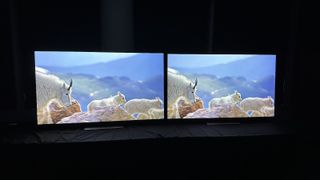We're only just getting used to QD-OLED and MLA OLED TVs, but another OLED TV panel technology has already appeared on the radar. So-called PHOLED involves an upgrade to phosphorescent materials for blue. Currently, all OLED TVs already use phosphorescence for red and green, but fluorescence for blue.
The company behind these fully phosphorescent panels, Universal Display Corporation, has told ETNews (thanks, FlatpanelsHD) that the upgrade to the blue OLED "can increase the luminous efficiency by 4 times". In other words, these panels should be capable of going brighter than current OLEDs.
There appears to be no reason that this new technology can't be combined with the new QD-OLED and MLA technology that's now allowing OLED TVs to hit vastly brighter peaks than ever before, which means we could be looking at yet another big jump in brightness in the near future.
How near? It could be as soon as next year, though Universal Display's Mike Hack told ETNews that ultimately the timescale will be determined by LG Display and Samsung Display, who currently manufacture all of the OLED panels used in current OLED TVs and who Universal Display will sell its technology to.
Whether these new fully phosphorescent OLED TVs will cost more is another unknown, with Mike Hack saying only that his company will provide its technology at "a reasonable price", which could mean anything really.
As ever, stay tuned for more info as we get it, and in the meantime check out our review of the LG G3, the world's first MLA-boosted OLED TV.
MORE:
Here are the best TVs you can currently buy
And these are the best OLED TVs
Don't forget the sound: here are the best Dolby Atmos soundbars we've tested

